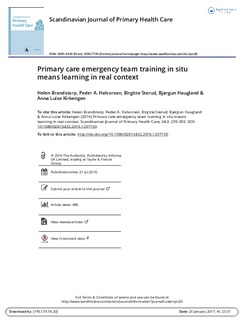| dc.contributor.author | Brandstorp, Helen | |
| dc.contributor.author | Halvorsen, Peder Andreas | |
| dc.contributor.author | Sterud, Birgitte | |
| dc.contributor.author | Haugland, Bjørgun | |
| dc.contributor.author | Kirkengen, Anna Luise | |
| dc.date.accessioned | 2017-01-27T15:37:54Z | |
| dc.date.available | 2017-01-27T15:37:54Z | |
| dc.date.created | 2016-08-12T07:46:55Z | |
| dc.date.issued | 2016 | |
| dc.identifier.citation | Scandinavian Journal of Primary Health Care. 2016, 34 (3), 295-303. | nb_NO |
| dc.identifier.issn | 0281-3432 | |
| dc.identifier.uri | http://hdl.handle.net/11250/2428810 | |
| dc.description.abstract | Objective: The purpose of our study was to explore the local learning processes and to improve in situ team training in the primary care emergency teams with a focus on interaction.
Design, setting and subjects: As participating observers, we investigated locally organised trainings of teams constituted ad hoc, involving nurses, paramedics and general practitioners, in rural Norway. Subsequently, we facilitated focus discussions with local participants. We investigated what kinds of issues the participants chose to elaborate in these learning situations, why they did so, and whether and how local conditions improved during the course of three and a half years. In addition, we applied learning theories to explore and challenge our own and the local participants’ understanding of team training.
Results: In situ team training was experienced as challenging, engaging, and enabling. In the training sessions and later focus groups, the participants discussed a wide range of topics constitutive for learning in a sociocultural perspective, and topics constitutive for patient safety culture. The participants expanded the types of training sites, themes and the structures for participation, improved their understanding of communication and developed local procedures. The flexible structure of the model mirrors the complexity of medicine and provides space for the participants’ own sense of responsibility.
Conclusion: Challenging, monthly in situ team trainings organised by local health personnel facilitate many types of learning. The flexible training model provides space for the participants’ own sense of responsibility and priorities. Outcomes involve social and structural improvements, including a sustainable culture of patient safety. | nb_NO |
| dc.language.iso | eng | nb_NO |
| dc.publisher | Taylor and Francis Open | nb_NO |
| dc.rights | Navngivelse-Ikkekommersiell 4.0 Internasjonal | * |
| dc.rights.uri | http://creativecommons.org/licenses/by-nc/4.0/deed.no | * |
| dc.title | Primary care emergency team training in situ means learning in real context | nb_NO |
| dc.type | Journal article | nb_NO |
| dc.type | Peer reviewed | nb_NO |
| dc.source.pagenumber | 295-303 | nb_NO |
| dc.source.volume | 34 | nb_NO |
| dc.source.journal | Scandinavian Journal of Primary Health Care | nb_NO |
| dc.source.issue | 3 | nb_NO |
| dc.identifier.doi | 10.1080/02813432.2016.1207150 | |
| dc.identifier.cristin | 1372272 | |
| dc.description.localcode | © 2016 The Author(s). Published by Informa UK Limited, trading as Taylor and Francis Group. This is an Open Access article distributed under the terms of the Creative Commons Attribution-NonCommercial License (http://creativecommons.org/licenses/by-nc/4.0/), which permits unrestricted non-commercial use, distribution, and reproduction in any medium, provided the original work is properly cited. | nb_NO |
| cristin.unitcode | 194,65,20,0 | |
| cristin.unitname | Institutt for samfunnsmedisin | |
| cristin.ispublished | true | |
| cristin.fulltext | original | |
| cristin.qualitycode | 1 | |

